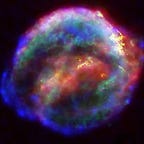Trappist 1 System
NASA’s Spitzer Space Telescope has revealed a new exoplanet discovery: the first known system of seven Earth-size planets around a single star. Three of these planets are firmly located in the habitable zone, the area around the parent star where a rocky planet is most likely to have liquid water.
Scientists are still finding and researching about the planets that are in the system there.
This system of seven rocky worlds–all of them with the potential for water on their surface–is an exciting discovery in the search for life on other worlds. There is the possibility that future study of this unique planetary system could reveal conditions suitable for life. In February 2018, a closer study of the seven planets suggested that some could harbor far more water than the oceans of Earth, in the form of atmospheric water vapor for the planets closest to their star, liquid water for others, and ice for those farthest away. The new study pinned down the density of each planet more precisely, making TRAPPIST-1 the most thoroughly known planetary system apart from our own.
What is Trappist System 1?
TRAPPIST-1 is named for the Transiting Planets and Planetesimals Small Telescope (TRAPPIST) in Chile, which discovered two of the seven planets we know of today — announced in 2016.
The TRAPPIST-1 planets huddle so close to one another that a person standing on the surface of one of these worlds would have a spectacular view of the neighboring planets in the sky. Those planets would sometimes appear larger than the Moon looks to an observer on Earth. They may also be tidally locked, meaning the same side of the planet is always facing the star, with each side in perpetual day or night. Although the planets are all closer to their star than Mercury is to the Sun, TRAPPIST-1 is such a cool star, some of its planets could still, in theory, hold liquid water.
This chart shows, on the top row, artist concepts of the seven planets of TRAPPIST-1 with their orbital periods, distances from their star, radii, masses, densities, and surface gravity as compared to those of Earth. Credit: NASA/JPL-Caltech
What might these planets look like?
It is impossible to know exactly how each planet looks because they are so far away. In our own solar system, the Moon and Mars have nearly the same density, yet their surfaces appear entirely different. Densities, while important clues to the planets’ compositions, do not say anything about habitability. However, our study is an important step forward as we continue to explore whether these planets could support life.
Based on available data, here are scientists’ best guesses about the appearances of the planets:
- TRAPPIST-1b, the innermost planet, is likely to have a rocky core, surrounded by an atmosphere much thicker than Earth’s. TRAPPIST-1c also likely has a rocky interior, but with a thinner atmosphere than planet b. TRAPPIST-1d is the lightest of the planets — about 30 percent the mass of Earth. Scientists are uncertain whether it has a large atmosphere, an ocean, or an ice layer — all three of these would give the planet an “envelope” of volatile substances, which would make sense for a planet of its density.
- Scientists were surprised that TRAPPIST-1e is the only planet in the system slightly denser than Earth, suggesting it may have a denser iron core than our home planet. Like TRAPPIST-1c, it does not necessarily have a thick atmosphere, ocean, or ice layer — making these two planets distinct in the system. It is mysterious why TRAPPIST-1e has a much rockier composition than the rest of the planets. In terms of size, density, and the amount of radiation it receives from its star, this is the most similar planet to Earth.
- TRAPPIST-1f, g, and h are far enough from the host star that water could be frozen as ice across these surfaces. If they have thin atmospheres, they would be unlikely to contain the heavy molecules of Earth, such as carbon dioxide.
It is interesting that the densest planets are not the ones that are the closest to the star, and that the colder planets cannot harbor thick atmospheres,
Next Steps
The next step in exploring TRAPPIST-1 will be NASA’s James Webb Space Telescope, which will be able to delve into the question of whether these planets have atmospheres and, if so, what those atmospheres are like. A recent study using NASA’s Hubble Space Telescope found no detection of hydrogen-dominated atmospheres on planets TRAPPIST-1d, e, and f — another piece of evidence for rocky composition — although the hydrogen-dominated atmosphere cannot be ruled out for g. Illustrations of these worlds will change as ongoing scientific investigations home in on their properties.
“Our conceptions of what these planets look like today may change dramatically over time,” said Robert Hurt, a senior visualization scientist at the Spitzer Science Center. “As we learn more about these planets, the pictures we make will evolve in response to our improved understanding.
“In the future, we may go on vacation to Trappist 1 the system”
